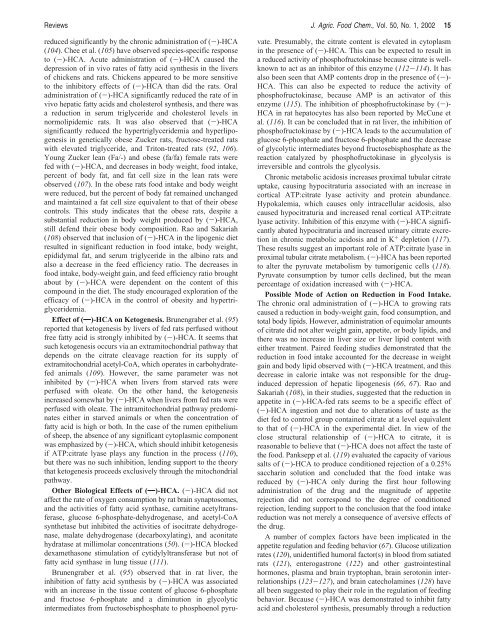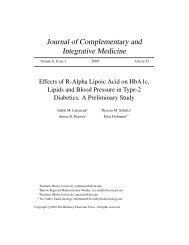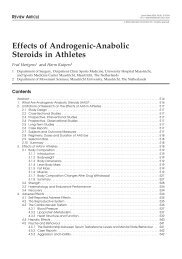Chemistry and Biochemistry of HCA.pdf - AFBoard.com
Chemistry and Biochemistry of HCA.pdf - AFBoard.com
Chemistry and Biochemistry of HCA.pdf - AFBoard.com
You also want an ePaper? Increase the reach of your titles
YUMPU automatically turns print PDFs into web optimized ePapers that Google loves.
Reviews J. Agric. Food Chem., Vol. 50, No. 1, 2002 15<br />
reduced significantly by the chronic administration <strong>of</strong> (-)-<strong>HCA</strong><br />
(104). Chee et al. (105) have observed species-specific response<br />
to (-)-<strong>HCA</strong>. Acute administration <strong>of</strong> (-)-<strong>HCA</strong> caused the<br />
depression <strong>of</strong> in vivo rates <strong>of</strong> fatty acid synthesis in the livers<br />
<strong>of</strong> chickens <strong>and</strong> rats. Chickens appeared to be more sensitive<br />
to the inhibitory effects <strong>of</strong> (-)-<strong>HCA</strong> than did the rats. Oral<br />
administration <strong>of</strong> (-)-<strong>HCA</strong> significantly reduced the rate <strong>of</strong> in<br />
vivo hepatic fatty acids <strong>and</strong> cholesterol synthesis, <strong>and</strong> there was<br />
a reduction in serum triglyceride <strong>and</strong> cholesterol levels in<br />
normolipidemic rats. It was also observed that (-)-<strong>HCA</strong><br />
significantly reduced the hypertriglyceridemia <strong>and</strong> hyperlipogenesis<br />
in genetically obese Zucker rats, fructose-treated rats<br />
with elevated triglyceride, <strong>and</strong> Triton-treated rats (92, 106).<br />
Young Zucker lean (Fa/-) <strong>and</strong> obese (fa/fa) female rats were<br />
fed with (-)-<strong>HCA</strong>, <strong>and</strong> decreases in body weight, food intake,<br />
percent <strong>of</strong> body fat, <strong>and</strong> fat cell size in the lean rats were<br />
observed (107). In the obese rats food intake <strong>and</strong> body weight<br />
were reduced, but the percent <strong>of</strong> body fat remained unchanged<br />
<strong>and</strong> maintained a fat cell size equivalent to that <strong>of</strong> their obese<br />
controls. This study indicates that the obese rats, despite a<br />
substantial reduction in body weight produced by (-)-<strong>HCA</strong>,<br />
still defend their obese body <strong>com</strong>position. Rao <strong>and</strong> Sakariah<br />
(108) observed that inclusion <strong>of</strong> (-)-<strong>HCA</strong> in the lipogenic diet<br />
resulted in significant reduction in food intake, body weight,<br />
epididymal fat, <strong>and</strong> serum triglyceride in the albino rats <strong>and</strong><br />
also a decrease in the feed efficiency ratio. The decreases in<br />
food intake, body-weight gain, <strong>and</strong> feed efficiency ratio brought<br />
about by (-)-<strong>HCA</strong> were dependent on the content <strong>of</strong> this<br />
<strong>com</strong>pound in the diet. The study encouraged exploration <strong>of</strong> the<br />
efficacy <strong>of</strong> (-)-<strong>HCA</strong> in the control <strong>of</strong> obesity <strong>and</strong> hypertriglyceridemia.<br />
Effect <strong>of</strong> ())-<strong>HCA</strong> on Ketogenesis. Brunengraber et al. (95)<br />
reported that ketogenesis by livers <strong>of</strong> fed rats perfused without<br />
free fatty acid is strongly inhibited by (-)-<strong>HCA</strong>. It seems that<br />
such ketogenesis occurs via an extramitochondrial pathway that<br />
depends on the citrate cleavage reaction for its supply <strong>of</strong><br />
extramitochondrial acetyl-CoA, which operates in carbohydratefed<br />
animals (109). However, the same parameter was not<br />
inhibited by (-)-<strong>HCA</strong> when livers from starved rats were<br />
perfused with oleate. On the other h<strong>and</strong>, the ketogenesis<br />
increased somewhat by (-)-<strong>HCA</strong> when livers from fed rats were<br />
perfused with oleate. The intramitochondrial pathway predominates<br />
either in starved animals or when the concentration <strong>of</strong><br />
fatty acid is high or both. In the case <strong>of</strong> the rumen epithelium<br />
<strong>of</strong> sheep, the absence <strong>of</strong> any significant cytoplasmic <strong>com</strong>ponent<br />
was emphasized by (-)-<strong>HCA</strong>, which should inhibit ketogenesis<br />
if ATP:citrate lyase plays any function in the process (110),<br />
but there was no such inhibition, lending support to the theory<br />
that ketogenesis proceeds exclusively through the mitochondrial<br />
pathway.<br />
Other Biological Effects <strong>of</strong> ())-<strong>HCA</strong>. (-)-<strong>HCA</strong> did not<br />
affect the rate <strong>of</strong> oxygen consumption by rat brain synaptosomes,<br />
<strong>and</strong> the activities <strong>of</strong> fatty acid synthase, carnitine acetyltransferase,<br />
glucose 6-phosphate-dehydrogenase, <strong>and</strong> acetyl-CoA<br />
synthetase but inhibited the activities <strong>of</strong> isocitrate dehydrogenase,<br />
malate dehydrogenase (decarboxylating), <strong>and</strong> aconitate<br />
hydratase at millimolar concentrations (50). (-)-<strong>HCA</strong> blocked<br />
dexamethasone stimulation <strong>of</strong> cytidylyltransferase but not <strong>of</strong><br />
fatty acid synthase in lung tissue (111).<br />
Brunengraber et al. (95) observed that in rat liver, the<br />
inhibition <strong>of</strong> fatty acid synthesis by (-)-<strong>HCA</strong> was associated<br />
with an increase in the tissue content <strong>of</strong> glucose 6-phosphate<br />
<strong>and</strong> fructose 6-phosphate <strong>and</strong> a diminution in glycolytic<br />
intermediates from fructosebisphosphate to phosphoenol pyruvate.<br />
Presumably, the citrate content is elevated in cytoplasm<br />
in the presence <strong>of</strong> (-)-<strong>HCA</strong>. This can be expected to result in<br />
a reduced activity <strong>of</strong> phosph<strong>of</strong>ructokinase because citrate is wellknown<br />
to act as an inhibitor <strong>of</strong> this enzyme (112-114). It has<br />
also been seen that AMP contents drop in the presence <strong>of</strong> (-)-<br />
<strong>HCA</strong>. This can also be expected to reduce the activity <strong>of</strong><br />
phosph<strong>of</strong>ructokinase, because AMP is an activator <strong>of</strong> this<br />
enzyme (115). The inhibition <strong>of</strong> phosph<strong>of</strong>ructokinase by (-)-<br />
<strong>HCA</strong> in rat hepatocytes has also been reported by McCune et<br />
al. (116). It can be concluded that in rat liver, the inhibition <strong>of</strong><br />
phosph<strong>of</strong>ructokinase by (-)-<strong>HCA</strong> leads to the accumulation <strong>of</strong><br />
glucose 6-phosphate <strong>and</strong> fructose 6-phosphate <strong>and</strong> the decrease<br />
<strong>of</strong> glycolytic intermediates beyond fructosebisphosphate as the<br />
reaction catalyzed by phosph<strong>of</strong>ructokinase in glycolysis is<br />
irreversible <strong>and</strong> controls the glycolysis.<br />
Chronic metabolic acidosis increases proximal tubular citrate<br />
uptake, causing hypocitraturia associated with an increase in<br />
cortical ATP:citrate lyase activity <strong>and</strong> protein abundance.<br />
Hypokalemia, which causes only intracellular acidosis, also<br />
caused hypocitraturia <strong>and</strong> increased renal cortical ATP:citrate<br />
lyase activity. Inhibition <strong>of</strong> this enzyme with (-)-<strong>HCA</strong> significantly<br />
abated hypocitraturia <strong>and</strong> increased urinary citrate excretion<br />
in chronic metabolic acidosis <strong>and</strong> in K + depletion (117).<br />
These results suggest an important role <strong>of</strong> ATP:citrate lyase in<br />
proximal tubular citrate metabolism. (-)-<strong>HCA</strong> has been reported<br />
to alter the pyruvate metabolism by tumorigenic cells (118).<br />
Pyruvate consumption by tumor cells declined, but the mean<br />
percentage <strong>of</strong> oxidation increased with (-)-<strong>HCA</strong>.<br />
Possible Mode <strong>of</strong> Action on Reduction in Food Intake.<br />
The chronic oral administration <strong>of</strong> (-)-<strong>HCA</strong> to growing rats<br />
caused a reduction in body-weight gain, food consumption, <strong>and</strong><br />
total body lipids. However, administration <strong>of</strong> equimolar amounts<br />
<strong>of</strong> citrate did not alter weight gain, appetite, or body lipids, <strong>and</strong><br />
there was no increase in liver size or liver lipid content with<br />
either treatment. Paired feeding studies demonstrated that the<br />
reduction in food intake accounted for the decrease in weight<br />
gain <strong>and</strong> body lipid observed with (-)-<strong>HCA</strong> treatment, <strong>and</strong> this<br />
decrease in calorie intake was not responsible for the druginduced<br />
depression <strong>of</strong> hepatic lipogenesis (66, 67). Rao <strong>and</strong><br />
Sakariah (108), in their studies, suggested that the reduction in<br />
appetite in (-)-<strong>HCA</strong>-fed rats seems to be a specific effect <strong>of</strong><br />
(-)-<strong>HCA</strong> ingestion <strong>and</strong> not due to alterations <strong>of</strong> taste as the<br />
diet fed to control group contained citrate at a level equivalent<br />
to that <strong>of</strong> (-)-<strong>HCA</strong> in the experimental diet. In view <strong>of</strong> the<br />
close structural relationship <strong>of</strong> (-)-<strong>HCA</strong> to citrate, it is<br />
reasonable to believe that (-)-<strong>HCA</strong> does not affect the taste <strong>of</strong><br />
the food. Panksepp et al. (119) evaluated the capacity <strong>of</strong> various<br />
salts <strong>of</strong> (-)-<strong>HCA</strong> to produce conditioned rejection <strong>of</strong> a 0.25%<br />
saccharin solution <strong>and</strong> concluded that the food intake was<br />
reduced by (-)-<strong>HCA</strong> only during the first hour following<br />
administration <strong>of</strong> the drug <strong>and</strong> the magnitude <strong>of</strong> appetite<br />
rejection did not correspond to the degree <strong>of</strong> conditioned<br />
rejection, lending support to the conclusion that the food intake<br />
reduction was not merely a consequence <strong>of</strong> aversive effects <strong>of</strong><br />
the drug.<br />
A number <strong>of</strong> <strong>com</strong>plex factors have been implicated in the<br />
appetite regulation <strong>and</strong> feeding behavior (67). Glucose utilization<br />
rates (120), unidentified humoral factor(s) in blood from satiated<br />
rats (121), enterogastrone (122) <strong>and</strong> other gastrointestinal<br />
hormones, plasma <strong>and</strong> brain tryptophan, brain serotonin interrelationships<br />
(123-127), <strong>and</strong> brain catecholamines (128) have<br />
all been suggested to play their role in the regulation <strong>of</strong> feeding<br />
behavior. Because (-)-<strong>HCA</strong> was demonstrated to inhibit fatty<br />
acid <strong>and</strong> cholesterol synthesis, presumably through a reduction




